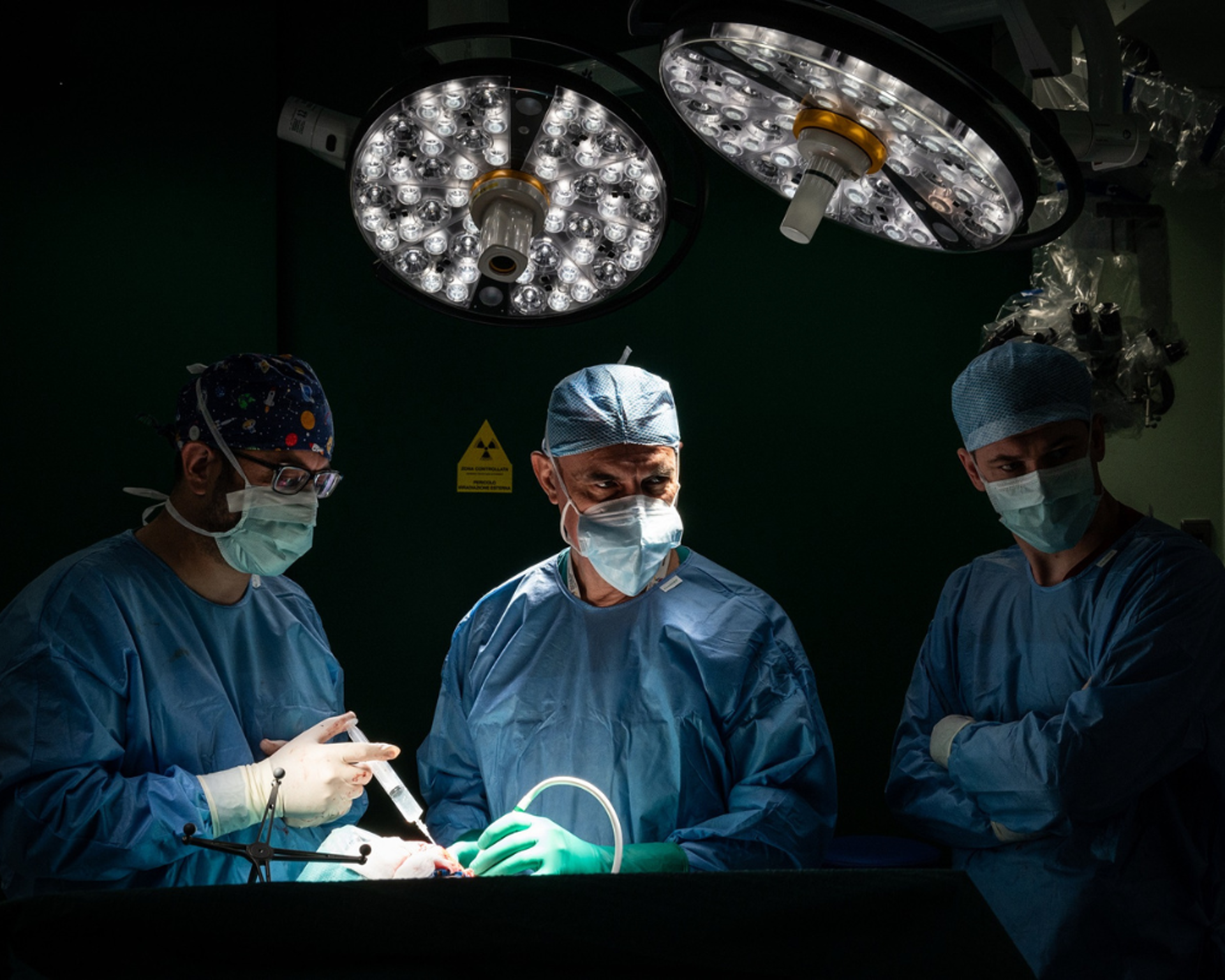San Raffaele, first-in-the-world demonstration of spinal cord stimulation efficacy for conus medullaris injury
/resolutions/res-l992x10000/Mortini_cono_midollare_UniSR-(1).png)
The study, published in Med by Cell Press and authored by physicians and researchers of the MINE Lab, documents the recovery of walking ability in a paraplegic patient with a spinal cord injury at T11–T12 level, thanks to epidural electrical stimulation. Injuries of this kind represent over 50% of spinal cord lesions.
The clinical case, published today in Med – Cell Press, was led by the multidisciplinary MINE Lab team, involving doctors, physiotherapists, and researchers from IRCCS San Raffaele Hospital in Milan and UniSR, alongside bioengineers from the Scuola Superiore Sant’Anna in Pisa, coordinated by Professor Silvestro Micera. The paper details the remarkable recovery of a 33-year-old man with a traumatic spinal cord injury at the T11–T12 level, extending to the conus medullaris, which caused severe motor deficits due to damage to both the central and peripheral nervous systems. After surgically implanting an epidural spinal cord neurostimulator, the team applied specific stimulation and rehabilitation protocols, significantly improving muscle strength, gait, and motor control.
This work is part of a research pathway that began with the first spinal cord neurostimulator implant performed in 2023 by the neurosurgery team at IRCCS San Raffaele Hospital, led by Professor Pietro Mortini, Chief of Neurosurgery at the Hospital and Full Professor of Neurosurgery at Vita-Salute San Raffaele University. The research progressed with the 2025 publication in Science Translational Medicine of initial results from two implanted patients, demonstrating the efficacy of the innovative epidural electrical stimulation protocol for treating spinal cord injuries.
“With this case study, we have demonstrated, for the first time, the effectiveness of epidural electrical stimulation (EES) combined with rehabilitation in restoring lower limb motor function in a patient with paraplegia caused by a severe injury involving the conus medullaris — the terminal portion of the spinal cord — allowing him to stand and walk short distances,”
explains Dr. Luigi Albano, neurosurgeon and researcher at IRCCS San Raffaele Hospital and first author of the study. “In addition to motor recovery, the stimulation also resulted in clinically significant improvements in neuropathic pain and overall quality of life.”
“The results of this study,” adds Professor Pietro Mortini, “bring new hope to patients with severe spinal cord injuries who have experienced prolonged immobility, by opening the door to recoveries that were once considered unthinkable, thanks to the integration of advanced neuromodulation and personalized rehabilitation.”

Conus Medullaris Injuries
The conus medullaris is the terminal portion of the spinal cord, located approximately between the first and second lumbar vertebrae (L1–L2). In this region, the central and peripheral nervous systems functionally converge. An injury in this area can therefore impair both motor and sensory functions in the lower limbs, as well as autonomic control of essential functions such as urination, defecation, and sexuality. These injuries, often caused by traffic accidents, falls, or violence, account for over 50% of spinal cord injuries involving the junction between the spinal cord and nerve roots.
“Because of the anatomical and functional complexity of this area, these injuries are among the most difficult to treat and often involve a combination of paraplegia, severe neuropathic pain, and sphincter dysfunction,” explains Dr. Luigi Albano. “Clinical presentations can vary from patient to patient, but in most cases, there are severe and persistent motor and sensory deficits that deeply impact quality of life and autonomy. Traditional therapeutic options are limited and mainly focused on rehabilitation, with generally modest recovery margins. It is in this context that epidural electrical stimulation could represent a potential game changer, opening up new treatment perspectives even for the most complex injuries.”
/resolutions/res-l1920x10000/Neurostimolazione_Mortini_UniSR-(2).png)
The Case Study
The subject of this study is a 33-year-old man who suffered a severe lower thoracic spinal cord injury (T11–T12) four years ago, resulting in paralysis of the lower limbs. The injury was classified as “incomplete” (grade C on the ASIA scale), but had significantly impaired his ability to move.
Despite undergoing two intensive rehabilitation cycles after the accident, the patient remained unable to walk or stand. Tests also showed damage to the nerve roots connecting the spinal cord to the leg muscles (L4 to S1), indicating involvement of both the central and peripheral nervous systems — a condition particularly difficult to treat, as traditional therapies rarely yield results when neural circuits are damaged at multiple levels. The patient was enrolled in the clinical trial Neuro-SCS-001, which evaluates the effects of epidural electrical stimulation combined with a personalized rehabilitation program.
“We implanted a spinal stimulation system with 32 electrodes, placing it between T11 and L1,” explains Professor Pietro Mortini. “Once activated, the stimulation re-engaged some residual neural circuits, particularly those controlling the trunk and hip flexor muscles, which are essential for recovering posture and gait. After an initial calibration phase, the patient followed an innovative rehabilitation program integrating virtual reality-based exercises using sensory and motor feedback.”
/resolutions/res-l1920x10000/Mortini_cono_midollare_UniSR-(2).png)
Multidisciplinary Rehabilitation Brings Measurable Results
Thanks to the innovative rehabilitation program developed by physiotherapists at IRCCS San Raffaele Hospital, the results were remarkable.
“In just three months, the patient showed a significant increase in hip joint range of motion, resulting in enhanced lower limb mobility,” explains Dr. Daniele Emedoli, physiotherapist and researcher at the Neurological-Cognitive-Motor Disorders Rehabilitation Unit at IRCCS San Raffaele Hospital. “There was also improvement in trunk posture control while seated, enabling balance without loss of stability, and an increased trunk flexion angle — only observed when the stimulator was active.”
Over time, the patient progressively reduced his need for assistance while walking: from treadmill exercises with body weight support, he moved on to walking with a walker and orthoses. Upon discharge, he was already able to walk 58 meters in six minutes and complete the 10-meter walk test in just over 40 seconds. The most striking achievement came six months after the procedure: he was able to walk independently for one kilometer using only a walker and orthoses.
“The success of this journey highlights the crucial importance of teamwork among physiotherapists, physiatrists, neurologists, neurosurgeons, and engineers,” comments Dr. Sandro Iannaccone, Director of the Rehabilitation Department at IRCCS San Raffaele Hospital. “Only through close collaboration and a multidisciplinary approach — integrating advanced neuromodulation techniques with tailored, tech-assisted rehabilitation — has it been possible to achieve such meaningful motor recovery.”
Information for Patients
People with spinal cord injuries interested in exploring diagnosis and treatment pathways with epidural electrical stimulation can contact IRCCS San Raffaele Hospital. A multidisciplinary team of neurosurgeons, neurologists, and physiotherapists evaluates each case individually, including within the framework of ongoing clinical studies. For more information, please write to: iocammino@hsr.it
You might be interested in

The microbiome as an ally against myeloma

Intrecci: a UniSR project for more inclusive and accessible cancer diagnosis

A New Approach to Enhance Immunotherapy in Multiple Myeloma
/resolutions/res-c660x528/Pensa_Aorta_Congresso_UniSR-(3).png)
